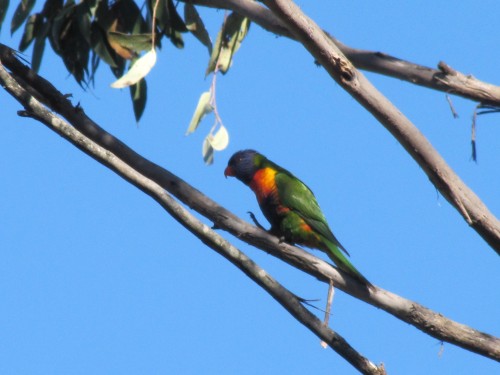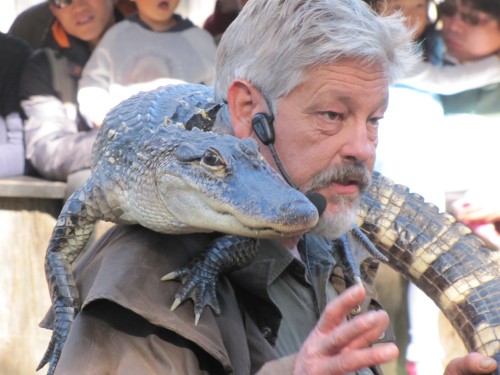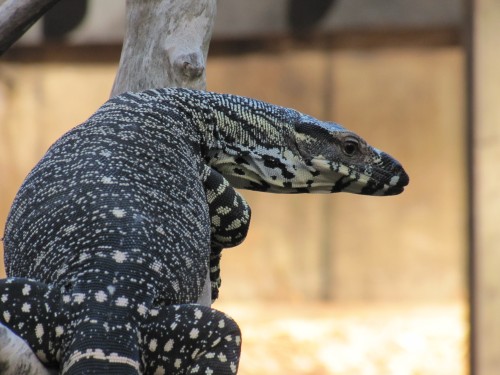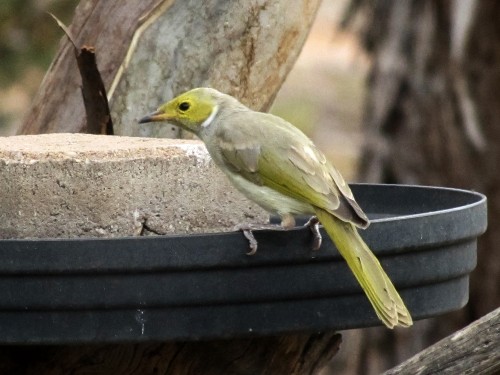Some birds of the Australian Reptile Park
During our visit to the Australian Reptile Park near Gosford, NSW last Sunday, we heard a very entertaining talk about reptiles given by one of the keepers. All through the talk I kept an eye out for any birds flying overhead or perched on nearby branches, such as the Rainbow Lorikeet shown above. This species of lorikeet was probably the most common bird in and around the park, their constant screeching giving a noisy background for all the talks. Another common species was the Sulphur-crested Cockatoo, also very raucous all around the park.
Featured in the presentation was the keeper’s pet alligator, Rosie, shown below. Rosie was well trained and very well behaved. Another animal shown by this keeper was the Lace Monitor, also shown below. The markings on the monitor, a large Australian lizard, are quite remarkable. The Lace Monitor, often called a goanna, is the second largest lizard in Australia. On one occasion I have seen this species in the bushland not far from my son’s home in inner North Shore Sydney.
Eastern Water Dragons, Botanic Gardens, Canberra
Visitors to the Australian National Botanic Gardens in Canberra cannot miss seeing a very common lizard that lives in the gardens, especially around the water features.
Numerous Eastern Water Dragons can be seen sunning themselves on rocks or on the paths.
Taking photos of them can be an interesting diversion from the excellent birding in the gardens. I guess even the plant enthusiasts can be intrigued in these interesting reptiles, especially if they nearly step on one.
Time for a bath: visitors to our bird bath
Some years ago we set up a birdbath on our patio area. It gave us much pleasure to see birds coming to drink and bathe. More recently we moved it to the other side of the house. Now it is in full view from our sunroom. It is here we often eat our meals, and work at the table with the birdbath in full view.
Over recent years, this location has had four main benefits:
- It is a great time waster investment; watching the birds go about their daily lives just a few metres from where we are sitting is both relaxing and refreshing to the body, mind and spirit.
- It is most entertaining, especially when a bird like a Mallee Ringneck Parrot comes to bathe and the water sprays in all directions.
- It is excellent for photography; with the 12X zoom on my camera, I have taken many close-up shots of the birds visiting. (Update: my new camera has a 20x zoom. Further update: I now have a camera with an 83x zoom.)
- It is educational; our human visitors marvel at our avian visitors and this gives us the opportunity to further enhance our friends’ appreciation of the natural environment.
I’ve actually installed three different baths in close proximity to one another; one on the ground (which the lizards sometimes use too), one at a height of about 60cm and the third at about 1.5m. This gives them choices. The nearby branches and bushes give them a place of refuge if they feel threatened in any way.
A List of Species that have visited our bird baths:
- Mallee Ringneck Parrot
- New Holland Honeyeater
- Spiny-cheeked Honeyeater
- Red Wattlebird
- Brown-headed Honeyeater
- Singing Honeyeater
- White-plumed Honeyeater
- House Sparrow
- Common Starling
- Little Raven
- Willie Wagtail
- Spotted Turtledove
- Crested Pigeon
- Spotted Pardalote
- Striated Pardalote
- Diamond Firetail Finch
- Yellow-rumped Thornbill
- Grey Shrike-thrush
- Australian Magpie
- Magpie Lark
- Mistletoebird
- Common Blackbird
- Rufous Whistler (see updates below)
- European Goldfinch (see updates below)
- Chestnut-rumped Thornbill (see updates below)
- Grey Fantail (see updates below)
- Black-faced Cuckoo-shrike (see updates below)
- Galah (see updates below)
- Grey Currawong (see updates below)
- Eastern Rosella (see updates below)
- Sacred Kingfisher (see updates below)
- Dusky Woodswallow (see updates below)
- White-browed Babblers (see updates below)
- White-winged Chough (see updates below)
- White-browed Woodswallow (see updates below)
- Purple-crowned Lorikeet (see updates below)
- Animals
- Red Fox
- Stumpy-tailed Lizard
- European Rabbit
- Brown Snake
- Blue-tongue Lizard
That’s quite a list!
UPDATE: More recently we have added the following species to the list:
- Rufous Whistler
- European Goldfinch
- Chestnut-rumped Thornbill
UPDATE #2 Two more species to add to the list:
- Stumpy-tail Lizard (also called a Shingleback Lizard)
- Red Fox – yes, that’s right, a fox.
- Brown Snake – passed close to the bird bath on the ground. In January 2016 a metre long Brown Snake actually stopped to have a drink. See photos here.
UPDATE #3 Another species to add to the list: Grey Fantail – it came to the bird bath briefly but left before I could take a photograph (4th May, 2007)
UPDATE #4 In January 2008 we had a single Black-faced Cuckoo-shrike come to drink briefly from the bird bath.
UPDATE #5 In late January 2008 a single Galah came to within a metre of the bird bath but did not drink. A few weeks later I added Grey Currawong to the list.
UPDATE #6 In December 2008 I added European Rabbit to the list.
UPDATE #7 In December 2009 I added Eastern Rosella. (Click here for a photo)
UPDATE #8 In November 2013 a Sacred Kingfisher perched about a metre from the bird bath but did not drink. In February 2014 a Dusky Woodswallow came to drink during one of our heat waves during a very hot summer.
UPDATE #9 In September 2015 I added White-winged Chough, White-browed Babbler and Blue-tongue Lizard (click for photo)
UPDATE #10 In December 2015, during a heatwave, I added White-browed Woodswallow.
UPDATE #11 In December 2020 I added Purple-crowned Lorikeet.
Comments: many of my readers have commented on this post – read them below and leave one of your own.
Update: this post was last updated on December 2020.











